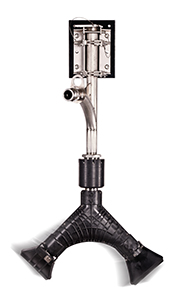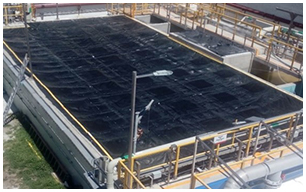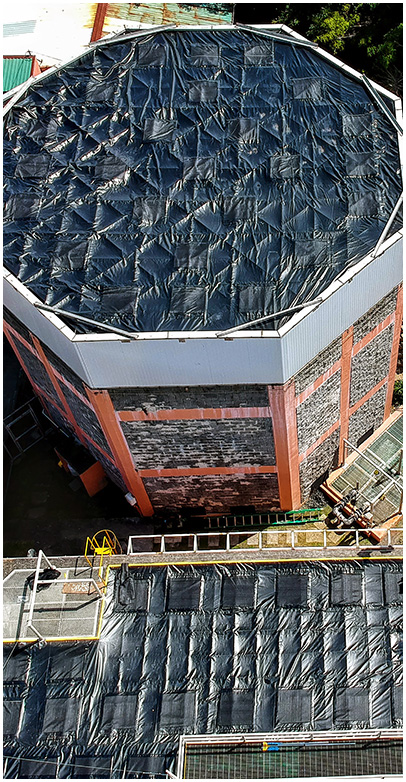Odor control
Psst: Do you have an odor problem?
Even too much of a typically pleasant odor at home—like baking bread—might not be so pleasantly received at industrial levels

Carbon-activated geomembrane filtration systems prevent internal plant odors from leaking into the surrounding community. Source: Anue Water Technologies
If you’ve ever baked bread or sweet breakfast rolls at home, you know how wonderful that fragrance can be, ramping up your appetite for a fresh slice out of the oven. But, that friendly fragrance from your kitchen—or early in the morning from the local bakery down the street—may not be what a community wants from an industrial-scale food plant, especially if it occurs around the clock.
Unfortunately, not all food plants generate what we might term friendly odors like baking bread or making chocolate. In fact, many generate pernicious odors that can land a food or beverage plant in big trouble with the surrounding community if the facility does nothing to prevent these odors from escaping. Whether it’s a plant’s process that directly creates the odor or its wastewater treatment facility, curbing odors is the way to remain a good citizen in the community.
 |
| Greg Bock, VP/general manager, Anue Water Technologies |
I had a recent discussion with Greg Bock, VP/general manager at Anue Water Technologies where we talked about—not water—but curbing odors from food and beverage plants. Anue Water Technologies got its start back in 2005 in Oceanside, California and has since relocated to Alpharetta, Georgia. Heavily involved with POTWs (publicly owned treatment works) in cleaning up water and the odors emanating from these facilities, the company thought it might lend its expertise in helping food and beverage plants clean up their water—and foul odors—if they have them.
Like dealing with ransomware attacks, it seems that foul odors escaping a plant are another thing that food and beverage plant operators would rather not talk about. After all, food facilities are environmentally conscious in cleaning up wastewater, so why not odors?
“Odor control doesn’t produce any revenue,” says Bock. “At the end of the day, it’s a cost center. They don’t want to deal with it, but they have to. A lot of the facilities that are being built today are putting money aside so they can be prepared for it. The older plants were built in the middle of nowhere 25-30 years ago, and now today, that facility has a half-million dollar house around the corner.”
Early on, a food processor could say it was the first resident in the area, so odor control wasn’t a priority—until new neighbors began to complain, says Bock. While new plants can handle odor control preemptively in the facility design, existing plants with an odor control problem have to figure out a way to handle it, but they also have to find a place for it in their budget, says Bock.
Looking backward and forward
 |
| Anue’s EnviroPrep (EP1100) removes FOG in wastewater. Source: Anue Water Technologies |
When Anue Water Technologies got its start, a group of really smart engineers worked on systems that would feed oxygen and ozone into municipal wastewater streams, says Bock. From there, they expanded their line of eco-friendly products to include the company’s EnviroPrep well-washer system, designed to address FOG (fats, oils, grease) in wastewater, which can be an issue in many food plants, and the Anue Geomembrane Covers for odor control.
“The most recent piece of equipment is our geomembrane technology, EOCS, or Engineered Odor Control System,” says Bock. “We started carrying that about two years ago, and it’s a really versatile product in that it’s a two-part piece of equipment.” The two parts can be used together or separately and consist of very dense rubber technology (geomembrane) and a filter technology to control odor, which is a patented carbon-impregnated filter that normally gets laid out in conjunction with the geomembrane device.
 |
| Geomembrane technology with carbon impregnated filters can be formed in any shape and size. Source: Anue Water Technologies |
The geomembrane technology, which incorporates the carbon impregnated filtration system, can be formed in many different configurations. It can be laid across round tanks, a rectangular tank. But you can also just use the carbon impregnated filters by themselves, says Bock.
The carbon impregnated filter technology comes as standard in one-meter-square sections, (3 ft, 3 inches) by about ¾-inch thick. “People have framed them and put them on an outside vent of a building to prevent the internal odors from exiting the building,” says Bock. “They can be secured easily with a wire tie or a pipe clamp around pipes exiting buildings such that the air that is exiting has to pass through the carbon. People have mounted the carbon impregnated filter to the underside of grated walks. They’ll lift up the grate, secure the membrane to the bottom of the grate, and they’ll put the grate back down above the tank or anything of that nature.”
Bock says the typical replacement period of one of the impregnated filters is 12-18 months—sometimes even two years, but their lifetime will depend upon what’s passing through them. But, there’s not much maintenance to them.
Putting the system to work in wastewater treatment
 |
| Anue Geomembrane filtration systems can accommodate any shape. In this application, they prevent ammonia and hydrogen sulfide gases from escaping into the nearby community. Source: Anue Water Technologies |
In certain wastewater treatment situations where odor is the primary problem to solve, fixing it may provide solutions to other plant issues as well, says Bock. For example, Coca-Cola’s largest franchisee, Coco-FEMSA, solved multiple challenges—odor control, safety enhancement, and cost reductions—in one of its ten large bottling plants in Brazil by installing the Anue Water Technologies’ reinforced geomembrane odor control system with integrated activated carbon filters at its on-site wastewater facility. While odor control was the primary reason that prompted plant management to take action; the installation of the patented Anue Geomembrane Covers also reduced significantly operating costs—including energy and chemical use—and greenhouse gases over the past three years.
The bottling plant is located in the quiet town of Marília, populated by 230,000 residents, about a five-hour drive from the megalopolis of São Paulo.
In 2017, complaints about odors from the wastewater facility at the plant were being received more frequently, particularly from a neighboring hotel. Meanwhile, the operators of the plant had also been looking into improving the safety of the wastewater tanks and investigating cost-saving practices that could be implemented. The Mexico City head office of Coca-Cola FEMSA, which already had several proven successful installations of Anue Geomembrane odor covers at other wastewater plants in various Latin American facilities (bottling, dairy & juice plants), recommended to the Marília plant managers that they consider installing the same system used elsewhere in their facilities to solve all of Marília’s challenges with one move.
The wastewater plant in Marília had two rectangular reactors with existing rigid covers, which were still emitting odors even while using costly odor-reducing chemicals. Coca-Cola FEMSA Marília decided to go ahead and install the reinforced membrane odor control system with integrated activated carbon filters on the two reactors. At the same time as these improvements were implemented, plans to build a new glass-lined steel homogenization tank were underway and it made sense to also cover it with Anue’s odor control solution.
The Anue Geomembrane Covers, which are suspended above the liquid, are made to fit each tank perfectly, providing a tight seal around the edges thus ensuring that all gases are forced toward the filters. One major advantage considered by plant managers when choosing the geomembrane covers for the new and existing tanks was the “breathability” of the carbon filters. The porosity of the filters prevents pressure from building up below the covers and the subsequent creation of dangerous gas build up in confined spaces—a key safety feature.
The filter design is engineered to allow gasses, such as hydrogen sulfide (H2S) and ammonia (NH3), and water to flow freely through the filters while they capture the odor-causing contaminants. Gas-specific filters for H2S and NH3 can be combined in the system for optimum control, even under grates and manhole covers.
To facilitate the operation and maintenance of the basins, access ports were included in the geomembranes’ design for each membrane, according to the customer’s specifications.
Third-party contractors installed the Anue geomembrane odor control system on both reactors and homogenization tank. First, they removed the old rigid covers on the reactors while the new homogenization tank was being built. The simple installation of covers was completed in a few days for both reactors. The installation work of the homogenization tank with the geomembrane odor control system was completed one month after the reactors together with the assembly of the prefabricated tank wall sections.
Once the covers were installed, no longer were any odors detected from the reactors. Consequently, odor complaints from the nearby hotel and community ceased completely following installation. Since the homogenization tank’s geomembrane covers were pre-installed before commissioning, there were never any discernible odors emanating from its inception.
What benefits were realized by the new system
The streamlined structure of the Anue geomembrane cover system, which integrates the activated carbon filters within the reinforced membrane in “pockets” for easy maintenance and filter changing, offers a potential space-saving benefit to wastewater facilities. Depending on the facility design, the geomembrane cover system could liberate the physical space occupied by pipes, pumps, and the chemical dosage unit because they are no longer needed.
Apart from having solved its odor problems, FEMSA Coca-Cola received a tremendously quick return on its investment. By eliminating the use of odor control chemicals, the wastewater facility managed to cover the cost of the three geomembrane odor control covers and the installation, for the equivalent of what it would have spent on the use of chemicals in a six- to eight-month period.
The only operational expenditures (OPEX) required with the geomembrane odor control system consists of changing the activated carbon filters on a regular basis. In the Marilia facility, the first filter change was done at the ten-month mark. One filter change (every 10 months) is equal to 2.5 weeks’ worth of chemicals they used to consume. Another monetary advantage not taken into account in these annual OPEX numbers are the cost-cutting benefits resulting from the reduction of energy consumption as well as labor and maintenance.
The timing of filter changes is a common concern of wastewater facility operators. On average, the lifespan of filters ranges from nine to fifteen months, based on practical experience in a variety of industrial and municipal wastewater plants. Various approaches are used to establish the lifetime of the filters. It is different in each case, depending on the type of gases emitted, intensity, flow, etc. Some wastewater facilities do sporadic checks with manual gas detection equipment. Others even invest in olfactometric analysis, but if there are no regulatory or other mandated requirements to use instruments for scientific odor monitoring, the easiest and most common method is to use olfactory senses. Staff at a wastewater facility will simply detect a gradually increasing odor level to indicate the time has come for a filter change. Unless the facility changes the treatment processes, after the first filter change, they will have a more accurate idea of the filter changing cycle for which to plan.
The carbon filters integrated into the three Anue geomembrane covers also function as water drains. For Marília, a town with a hot climate and a torrential rainy season, this additional benefit is invaluable. Rain falls throughout the year in Marília, but there is extreme seasonal variation in the monthly rainfall. Most of the rain falls during the 31 days centered around January 10, with an average total accumulation of 7.8 inches.
Since early 2018, the three geomembrane covers, installed at the wastewater facility at FEMSA-Coca Cola’s Marília bottling plant, have kept odors under control and the soft drink facility free from complaints. With a payback of less than one year, the environmentally-friendly, chemical free odor control system has also achieved a massive reduction in operating cost—as well as helping the company meet its sustainability objectives of reducing greenhouse gases and protecting the global environment.
For more information, find Anue Water Technologies at www.AnueWater.com or email info@anuewater.com.
Looking for a reprint of this article?
From high-res PDFs to custom plaques, order your copy today!






